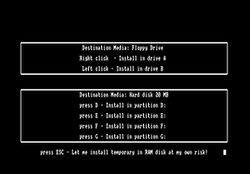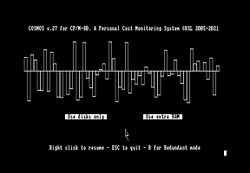Difference between revisions of "Cosmos"
m |
|||
| (35 intermediate revisions by the same user not shown) | |||
| Line 1: | Line 1: | ||
| − | + | [[Image:COSMOS_set_up.jpg|right|thumb|250px|COSMOS installation utility]] | |
| + | [[Image:COSMOS_Initial_Screen.jpg|right|thumb|250px|COSMOS initial screen]] | ||
| − | + | '''COSMOS''' is a personal '''COS'''t '''MO'''nitoring '''S'''ystem programed by [[KSL|KSL]] for the CPC6128 and [[CP/M]]-80 operating system, the latter being the industry standard of the late 70s - early 80s. This budget monitoring system is a business application similar to the MSDOS-era PC applications and one of the most recent (2021) projects developed for CP/M. Unlike most applications for CP/M, COSMOS is built upon the '''mouse based graphics user interface''' as pioneered by Xerox at Palo Alto and popularized by Apple with the Lisa and Macintosh computers. Nowadays, COSMOS can be used on an everyday basis (using [[CaPriCe]] or [[WinCPC]] or a real CPC) in order to edit the daily income, plan the monthly expenses and perform trial and error analyses aiming at maximizing the annual profit. Notice that COSMOS also contains the latest version of [[ASCII Tools]]. | |
| − | + | COSMOS has been developed on the basis of the hardware peripherals as well as the software that were (contemporary) available for the CP/M and the CPC6128: the 512 KB [[Dobbertin Memory Expansion]], the [[ParaDOS]] or [[X-DDOS]] ROMS for the external (800 KB) floppy drive, the 20 MB [[Dobbertin Harddisc]], the [[Amstrad Serial Interface]], the Amstrad Parallel [[Printer Port]], the [[CTM640/CTM644]] colour monitor, the [[AMX Mouse]], the [[MicroScript]] (142 KB), the [[WordStar]] (706 KB), the [[Protext]] (406 KB), the [[Multiplan]] (208 KB), the [[SuperCalc 2]] (240 KB), the [[DBase II]] (272 KB), the [[DR Draw]] (235 KB), the [[DR Graph]] (306 KB), the [[MAXAM]] (206 KB), the [[Atlast Plus]] (224 KB) and other [[Programming software]]. COSMOS includes its own graphics routines (similar to [[GSX]]), its own graphics screen saver, is based on the [[Dobbertin]] version of CP/M 2.2 (v1.2) which provides 59 KB TPA, supports the RAM expansion and the 20 MB hard disk. | |
| − | + | ||
| − | + | In addition to the command and chain files, COSMOS original disc also contains the CP/M 2.2 (v1.2) boot sectors as well as an installation utility. By executing the latter utility (A>SETUP) the user can initialize any annual project or start a temporary project in order to become familiar with the COSMOS user interface and functions. Upon installing COSMOS in drive B or HD20 it is suggested to execute COSMOS using all the available extra RAM (no RAM load minimization) and to use a new empty CP/M 2.2 (v1.2) boot disk in drive A as the redundant disk. A full annual project of COSMOS, including the user attachments, the user block of invoices, the summary files as well as the user agenda notices requires minimum 350 KB of disc space. | |
| + | As far as the controls are concerned, '''Cursor keys''' or '''Mouse''' can be used in order to control the pointer. '''[F0]''' key simulates the left button of the mouse, whereas '''[F.]''' key simulates the right button of the mouse. Left button can be used for (Yes), whereas the right button can be used for (No),(Next) or (On-Board) help. ESC key can be used to quit. | ||
| + | To download the final version of COSMOS (v.27) use the link located at the bottom of this page. Boot CP/M 2.2 v1.2 using the original COSMOS disk and execute A>SETUP.COM. | ||
== Download == | == Download == | ||
| − | * [http://www.cpcwiki.eu/index.php/File: | + | * [http://www.cpcwiki.eu/index.php/File:COSMOS_v27.dsk Download from CPCWiki] |
[[Category:Applications]] | [[Category:Applications]] | ||
[[Category:CP/M]] | [[Category:CP/M]] | ||
[[Category:Manual]] | [[Category:Manual]] | ||
Latest revision as of 09:00, 9 March 2025
COSMOS is a personal COSt MOnitoring System programed by KSL for the CPC6128 and CP/M-80 operating system, the latter being the industry standard of the late 70s - early 80s. This budget monitoring system is a business application similar to the MSDOS-era PC applications and one of the most recent (2021) projects developed for CP/M. Unlike most applications for CP/M, COSMOS is built upon the mouse based graphics user interface as pioneered by Xerox at Palo Alto and popularized by Apple with the Lisa and Macintosh computers. Nowadays, COSMOS can be used on an everyday basis (using CaPriCe or WinCPC or a real CPC) in order to edit the daily income, plan the monthly expenses and perform trial and error analyses aiming at maximizing the annual profit. Notice that COSMOS also contains the latest version of ASCII Tools.
COSMOS has been developed on the basis of the hardware peripherals as well as the software that were (contemporary) available for the CP/M and the CPC6128: the 512 KB Dobbertin Memory Expansion, the ParaDOS or X-DDOS ROMS for the external (800 KB) floppy drive, the 20 MB Dobbertin Harddisc, the Amstrad Serial Interface, the Amstrad Parallel Printer Port, the CTM640/CTM644 colour monitor, the AMX Mouse, the MicroScript (142 KB), the WordStar (706 KB), the Protext (406 KB), the Multiplan (208 KB), the SuperCalc 2 (240 KB), the DBase II (272 KB), the DR Draw (235 KB), the DR Graph (306 KB), the MAXAM (206 KB), the Atlast Plus (224 KB) and other Programming software. COSMOS includes its own graphics routines (similar to GSX), its own graphics screen saver, is based on the Dobbertin version of CP/M 2.2 (v1.2) which provides 59 KB TPA, supports the RAM expansion and the 20 MB hard disk.
In addition to the command and chain files, COSMOS original disc also contains the CP/M 2.2 (v1.2) boot sectors as well as an installation utility. By executing the latter utility (A>SETUP) the user can initialize any annual project or start a temporary project in order to become familiar with the COSMOS user interface and functions. Upon installing COSMOS in drive B or HD20 it is suggested to execute COSMOS using all the available extra RAM (no RAM load minimization) and to use a new empty CP/M 2.2 (v1.2) boot disk in drive A as the redundant disk. A full annual project of COSMOS, including the user attachments, the user block of invoices, the summary files as well as the user agenda notices requires minimum 350 KB of disc space.
As far as the controls are concerned, Cursor keys or Mouse can be used in order to control the pointer. [F0] key simulates the left button of the mouse, whereas [F.] key simulates the right button of the mouse. Left button can be used for (Yes), whereas the right button can be used for (No),(Next) or (On-Board) help. ESC key can be used to quit.
To download the final version of COSMOS (v.27) use the link located at the bottom of this page. Boot CP/M 2.2 v1.2 using the original COSMOS disk and execute A>SETUP.COM.

